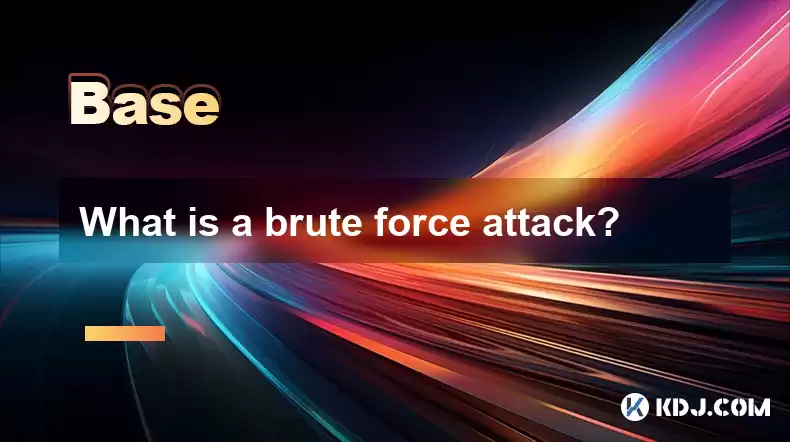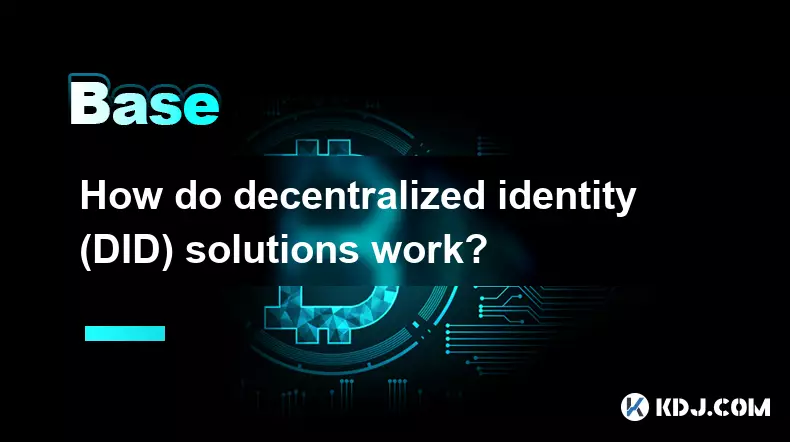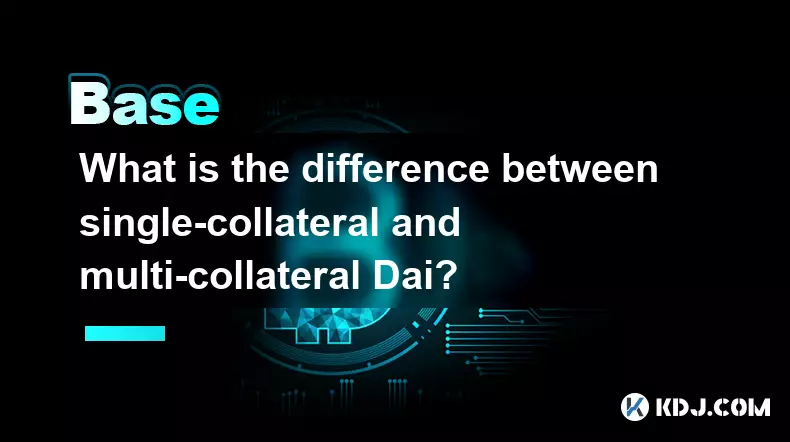-
 bitcoin
bitcoin $108309.944805 USD
-1.81% -
 ethereum
ethereum $3861.653445 USD
-2.57% -
 tether
tether $1.000476 USD
0.02% -
 bnb
bnb $1064.809647 USD
-3.07% -
 xrp
xrp $2.422923 USD
-2.29% -
 solana
solana $186.552328 USD
-0.93% -
 usd-coin
usd-coin $0.999917 USD
0.00% -
 tron
tron $0.322438 USD
-0.01% -
 dogecoin
dogecoin $0.194315 USD
-2.57% -
 cardano
cardano $0.642133 USD
-3.06% -
 chainlink
chainlink $17.657259 USD
-6.17% -
 hyperliquid
hyperliquid $35.120261 USD
-7.45% -
 ethena-usde
ethena-usde $0.999614 USD
0.03% -
 stellar
stellar $0.312748 USD
-3.27% -
 bitcoin-cash
bitcoin-cash $480.377391 USD
0.23%
What is a brute force attack?
Brute-force attacks, though computationally expensive, threaten cryptocurrencies by trying all possible keys to unlock wallets. Stronger encryption, longer keys, and multi-factor authentication are crucial countermeasures.
Mar 05, 2025 at 10:12 pm

- Brute-force attacks are a trial-and-error method used to guess cryptographic keys or passwords.
- They are computationally expensive and time-consuming, especially with strong encryption.
- Cryptocurrencies are vulnerable to brute-force attacks if their key lengths are insufficient or their security protocols are weak.
- Various countermeasures exist to mitigate the risk of successful brute-force attacks.
- Understanding the limitations and vulnerabilities helps in developing stronger security practices.
A brute-force attack is a method of attempting to gain unauthorized access to a system by systematically trying every possible combination of characters, numbers, and symbols until the correct one is found. In the context of cryptocurrencies, this typically involves trying to guess private keys or passwords associated with digital wallets or exchanges. The attacker essentially throws every possible key at the system until one unlocks the desired access. This is a non-targeted approach, relying solely on computational power and time.
How Brute Force Attacks Target Cryptocurrencies:Cryptocurrencies rely heavily on cryptography for security. Private keys, long strings of characters, are essential for authorizing transactions. A successful brute-force attack would allow an attacker to gain control of a cryptocurrency wallet and its associated funds. The vulnerability arises when private keys are not sufficiently long or complex, leaving them susceptible to being cracked through exhaustive searching. Weak or easily guessed passwords also contribute to the vulnerability.
Factors Affecting the Success of a Brute Force Attack:Several factors influence the feasibility and success rate of a brute-force attack against cryptocurrency systems. The most critical factor is the length and complexity of the cryptographic key or password. Longer keys with a higher degree of randomness require exponentially more computational power and time to crack. The attacker's computational resources, including the number of computers and their processing power, also play a crucial role. The algorithm used for encryption also impacts the difficulty. Stronger encryption algorithms naturally make brute-force attacks significantly harder.
Countermeasures Against Brute Force Attacks:Several methods can be employed to mitigate the risk of successful brute-force attacks on cryptocurrencies:
- Using strong, long, and random private keys: Generating keys using robust random number generators and employing sufficient key lengths significantly increases the time and resources required for a brute-force attack.
- Implementing rate limiting: This technique restricts the number of login attempts from a single IP address within a specific timeframe. This can help to slow down or even prevent brute-force attempts.
- Employing multi-factor authentication (MFA): MFA adds an extra layer of security by requiring multiple forms of verification, making it significantly harder for attackers to gain access even if they obtain a password or private key.
- Utilizing hardware security modules (HSMs): HSMs are physical devices that securely store and manage cryptographic keys, making them more resistant to brute-force attacks.
- Regularly updating software and security protocols: Staying up-to-date with the latest security patches helps to address vulnerabilities that could be exploited by attackers.
- Employing robust password management practices: This includes using strong, unique passwords for each account and utilizing a password manager to securely store and manage these credentials.
Hashing functions are one-way cryptographic functions that transform input data into a fixed-size string of characters. In the context of cryptocurrencies, hashing is used to secure passwords and protect private keys. While hashing makes it computationally infeasible to reverse the process and obtain the original data, a brute-force attack can still be employed by trying different inputs until the correct hash is generated. The strength of the hashing algorithm directly impacts the difficulty of such an attack. Stronger hashing algorithms increase the computational effort required for a brute-force attempt.
Brute Force Attacks and Bitcoin:Bitcoin's security relies heavily on the cryptographic strength of its private keys. A brute-force attack against a Bitcoin wallet would involve trying every possible private key until the correct one is found, allowing the attacker to spend the Bitcoin associated with that wallet. The sheer number of possible private keys makes a successful brute-force attack extremely improbable with currently available computing power. However, the vulnerability still exists, emphasizing the importance of strong key management and security practices.
Brute Force Attacks and Other Cryptocurrencies:The vulnerability to brute-force attacks is not unique to Bitcoin; other cryptocurrencies are equally susceptible. The security of any cryptocurrency relies on the strength of its cryptographic algorithms and the robustness of its security protocols. Cryptocurrencies with shorter key lengths or weaker encryption algorithms are naturally more vulnerable to brute-force attacks.
The Importance of Key Length:The length of a cryptographic key is a crucial factor determining its resistance to brute-force attacks. Longer keys have a significantly larger number of possible combinations, making them exponentially harder to crack. Cryptocurrencies typically use keys of sufficient length to make brute-force attacks practically infeasible.
Computational Resources and Brute Force Attacks:The computational resources available to an attacker significantly influence the feasibility of a brute-force attack. More powerful computers and distributed computing networks can significantly increase the speed at which potential keys can be tested. However, even with substantial resources, cracking long and complex keys remains computationally expensive and time-consuming.
Frequently Asked Questions:Q: Can a brute-force attack be completely prevented?A: While a brute-force attack can't be completely prevented, its likelihood can be drastically reduced through the implementation of strong security measures, such as long and complex keys, multi-factor authentication, and robust security protocols.
Q: How long would a brute-force attack take?A: The time required for a brute-force attack depends on the key length, the strength of the encryption algorithm, and the attacker's computational resources. For sufficiently long keys, it could take years, decades, or even longer.
Q: Are all cryptocurrencies equally vulnerable to brute-force attacks?A: No, the vulnerability to brute-force attacks varies depending on the specific cryptocurrency's cryptographic algorithms, key lengths, and security practices. Cryptocurrencies with stronger encryption and longer keys are more resistant.
Q: What should I do to protect my cryptocurrency from brute-force attacks?A: Use strong, randomly generated private keys, enable two-factor authentication, keep your software updated, and use a reputable and secure wallet. Avoid using weak or easily guessable passwords.
Disclaimer:info@kdj.com
The information provided is not trading advice. kdj.com does not assume any responsibility for any investments made based on the information provided in this article. Cryptocurrencies are highly volatile and it is highly recommended that you invest with caution after thorough research!
If you believe that the content used on this website infringes your copyright, please contact us immediately (info@kdj.com) and we will delete it promptly.
- Stablecoins, Gaming Economy, and Blockchain Gaming: A New Era of Predictability
- 2025-10-22 22:30:12
- BlockDAG's Crypto Surge: Redefining Innovation Beyond BNB and Litecoin
- 2025-10-22 23:15:12
- Meme Coins, Crypto Dip, and MemeCore: Riding the Wave in a Volatile Market
- 2025-10-22 22:50:12
- Melania Trump, Memecoin Scam, and Lawsuit: A New York Minute on Crypto Chaos
- 2025-10-22 22:50:12
- US Mint Mania: Silver Eagles, Liberty Gold, and the Navy's High Seas Heist!
- 2025-10-22 22:55:12
- Solana Meme Coins: Igniting the Next Rally?
- 2025-10-22 22:30:12
Related knowledge

How do decentralized identity (DID) solutions work?
Oct 14,2025 at 11:36pm
Understanding Decentralized Identity in the Blockchain Ecosystem1. Decentralized identity (DID) solutions are built on blockchain networks, allowing i...

What is the difference between Near Protocol and Ethereum?
Oct 15,2025 at 08:01am
Near Protocol and Ethereum: Core Architectural Differences1. Near Protocol operates on a sharded blockchain architecture known as Nightshade, which al...

What does it mean for code to be "open source" in crypto?
Oct 12,2025 at 01:54pm
Understanding Open Source in the Cryptocurrency Ecosystem1. In the context of cryptocurrency, open source refers to software whose code is publicly ac...

What is the purpose of a "testnet"?
Oct 12,2025 at 09:01am
Understanding the Role of Testnets in Blockchain Development1. A testnet serves as a parallel version of a blockchain network, designed specifically f...

How to avoid phishing scams in crypto?
Oct 13,2025 at 06:18pm
Understanding Common Crypto Phishing Tactics1. Cybercriminals frequently use fake websites that mirror legitimate crypto exchanges or wallet platforms...

What is the difference between single-collateral and multi-collateral Dai?
Oct 12,2025 at 05:18pm
Understanding Single-Collateral Dai1. Single-Collateral Dai (SCD) was the original version of the Dai stablecoin launched by MakerDAO in 2017. It allo...

How do decentralized identity (DID) solutions work?
Oct 14,2025 at 11:36pm
Understanding Decentralized Identity in the Blockchain Ecosystem1. Decentralized identity (DID) solutions are built on blockchain networks, allowing i...

What is the difference between Near Protocol and Ethereum?
Oct 15,2025 at 08:01am
Near Protocol and Ethereum: Core Architectural Differences1. Near Protocol operates on a sharded blockchain architecture known as Nightshade, which al...

What does it mean for code to be "open source" in crypto?
Oct 12,2025 at 01:54pm
Understanding Open Source in the Cryptocurrency Ecosystem1. In the context of cryptocurrency, open source refers to software whose code is publicly ac...

What is the purpose of a "testnet"?
Oct 12,2025 at 09:01am
Understanding the Role of Testnets in Blockchain Development1. A testnet serves as a parallel version of a blockchain network, designed specifically f...

How to avoid phishing scams in crypto?
Oct 13,2025 at 06:18pm
Understanding Common Crypto Phishing Tactics1. Cybercriminals frequently use fake websites that mirror legitimate crypto exchanges or wallet platforms...

What is the difference between single-collateral and multi-collateral Dai?
Oct 12,2025 at 05:18pm
Understanding Single-Collateral Dai1. Single-Collateral Dai (SCD) was the original version of the Dai stablecoin launched by MakerDAO in 2017. It allo...
See all articles










































































